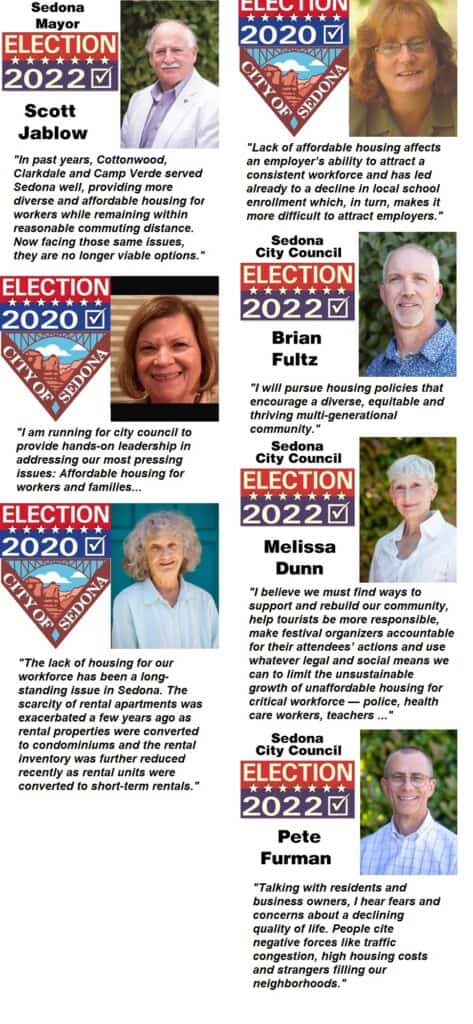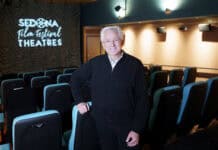Last month Sedona City Council heard a pitch from a Baltimore-based consulting firm about reasons to jack up Sedona’s already-high development fees. Council members seemed aghast to learn the fees we’re charged to build a home in Sedona are far and away more expensive than those charged by any other local community that the out-of-state consultant investigated.
Did council suddenly find its sanity about the sheer cost of building a home in Sedona?
“We were highest to begin with and we are three times higher after the proposed fees,” Councilwoman Jessica Williamson said, while Councilwoman Kathy Kinsella said, “There will be reaction out there to those numbers,” and Councilman Pete Furman adroitly remarked, “When you look at this stuff, it sure looks like we’re trying to prevent housing.”
Surely their shock meant that council would look at reducing some of these intimidating costs to build a single-family home within city limits. After all, when running for office, our elected council members repeated that housing costs were a top concern — and their intention of doing something about it was one reason they asked for your vote.

So that’s why it’s unfathomable that Sedona City Council members openly betrayed themselves on Tuesday, Oct. 8, when they voted unanimously to move forward on raising Sedona’s already atrocious development fees — and nearly double them. Council seems happy to hike these fees to bring the city a few more drops of income while Sedona’s families are struggling under record inflation, reminiscent of when council voted in 2021 to make Sedona’s supposedly temporary half-cent sales tax hike permanent — disproportionately affecting the working class and seniors on fixed incomes.
Council wants to squeeze every dime it can from residents, tourists, property owners and, most offensively, every working-class Sedonan, renter, senior and working family surviving on limited incomes.
Council’s plan to jack up building costs is obscene, but it fits with their apparent goal of killing a Sedona community where the wealthy, middle class and workers can all find a comfortable balance and instead turning Sedona into the next Aspen, Telluride or Scottsdale.
Council apparently wants to legally steal money via a “pay for play” taxation scheme to score points with campaign donors by building pickleball courts, shifting police away from crime to enforce an OHV speed limit in a single neighborhood lined with already-expensive homes, paying a traffic guard to halt “riff-raff” from driving down Back o’ Beyond Road with its multi-million-dollar estates, or building sidewalks in some of Sedona’s wealthiest neighborhoods — which second-home owners rarely use on the occasions when they are here.
Even the simplest floor plan and the most basic amenities for a new, modest house will be unobtainable for workers, thanks to the massive taxes imposed on them to fill the city’s swelling coffers. Nearly every council member owns a home worth over a million dollars, so why would they have to worry about adding to the cost of building workforce housing or a single-family home?
Meanwhile, Sedona’s poor and middle-class neighborhoods — whose residents don’t have excess income to donate to mayoral and council member reelection campaigns — still have asphalt abutting private property and are still stepping aside for cars driven by fellow workers heading home after a hot day of serving the very folks who are intentionally ignoring their neighborhoods.
The city isn’t building a recreation center or parks.
The city owns no fire department.
Police staffing is stagnant, but somehow the city is still hiring more and more administrators to run programs with marginal community benefit.
The higher fees will make short-term rentals more likely, not less. High development fees will transform Sedona from a financially-diverse community into one where only the uber-wealthy can afford to pay to play, leading to old homes being torn down to build McMansions, many of which will be built as short-term rentals — the only profitable industry Sedona has besides tourism.
This cynical, cyclical feedback loop will strip away Sedona’s less valuable homes on increasingly expensive parcels one by one until Sedona is nothing but gated communities locking out Sedona’s workforce, who will have moved to surrounding communities. In a few years, council won’t have to worry about pesky biennial campaign demands for “workforce housing,” because Sedona won’t be home to any workers who can afford the astronomical rents for 4,000- square-foot palatial villas. Sedona’s businesses will have to pay higher wages to make working in our city worth the long drive from Camp Verde, Rimrock, Cottonwood, Cornville and Clarkdale, passing on those expenses to customers.
Every election cycle, council candidates pretend to care about Sedona’s working class, but this vote means they can kiss any “workforce housing” goodbye — not that any sane Sedona resident ever thought it would be possible anyway.
“When you look at this stuff, it sure looks like we’re trying to prevent housing,” Furman said.
No, councilman, you and your six colleagues aren’t “trying to prevent housing” — you are preventing housing.
Council can still do the right thing and claw back these development fees, especially for single-family homes and housing complexes, to encourage builders to make smaller homes for renters that are worth the expense to build them.
















![Median-housing-price-Sedona[1]](https://www.redrocknews.com/wp-content/uploads/2024/10/Median-housing-price-Sedona1-696x509.jpg)


